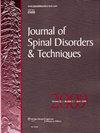Microscopic Posterior Transdural Resection of Cervical Retro-Odontoid Pseudotumors
Q Medicine
引用次数: 21
Abstract
Retro-odontoid pseudotumors are noninflammatory masses formed posterior to the odontoid process. Because of their anatomy, the optimal surgical approach for resecting pseudotumors is controversial. Conventionally, 3 approaches are used: the anterior transoral approach, the lateral approach, and the posterior extradural approach; however, each approach has its limitations. The posterior extradural approach is the most common; however, it remains challenging due to severe epidural veins. Although regression of pseudotumors after fusion surgery has been reported, direct decompression and a pathologic diagnosis are ideal when the pseudotumor is large. We therefore developed a new microscopic surgical technique; transdural resection. After C1 laminectomy, the dorsal and ventral dura was incised while preserving the arachnoid. Removal of the pseudotumor was performed and both of the dura were repaired. The patient’s clinical symptoms subsequently improved and the pathologic findings showed degenerative fibrocartilaginous tissue. In addition, no neurological deterioration, central spinal fluid leakage, or arachnoiditis was observed. Currently, the usefulness of the transdural approach has been reported for cervical and thoracic disk herniation. According to our results, the transdural approach is recommended for resection of retro-odontoid pseudotumors because it enables direct decompression of the spinal cord and a pathologic diagnosis.显微后经硬膜切除颈齿状后假瘤
齿状突后假性肿瘤是齿状突后形成的非炎性肿块。由于假肿瘤的解剖结构,切除假肿瘤的最佳手术方法存在争议。通常有三种入路:前经口入路、外侧入路和后硬膜外入路;然而,每种方法都有其局限性。后硬膜外入路是最常见的;然而,由于严重的硬膜外静脉,它仍然具有挑战性。虽然假肿瘤在融合手术后消退已有报道,但当假肿瘤较大时,直接减压和病理诊断是理想的。因此,我们开发了一种新的显微手术技术;transdural切除。C1椎板切除术后,切开硬脑膜背侧和腹侧,保留蛛网膜。假性肿瘤切除,双硬脑膜修复。患者的临床症状随后改善,病理表现为退行性纤维软骨组织。此外,未观察到神经系统恶化、中枢性脊髓液漏或蛛网膜炎。目前,经硬膜入路治疗颈、胸椎间盘突出症的有效性已有报道。根据我们的结果,经硬膜入路被推荐用于切除齿状突后假肿瘤,因为它可以直接减压脊髓和病理诊断。
本文章由计算机程序翻译,如有差异,请以英文原文为准。
求助全文
约1分钟内获得全文
求助全文
来源期刊
CiteScore
2.16
自引率
0.00%
发文量
0
审稿时长
3 months
期刊介绍:
Journal of Spinal Disorders & Techniques features peer-reviewed original articles on diagnosis, management, and surgery for spinal problems. Topics include degenerative disorders, spinal trauma, diagnostic anesthetic blocks, metastatic tumor spinal replacements, management of pain syndromes, and the use of imaging techniques in evaluating lumbar spine disorder. The journal also presents thoroughly documented case reports.

 求助内容:
求助内容: 应助结果提醒方式:
应助结果提醒方式:


